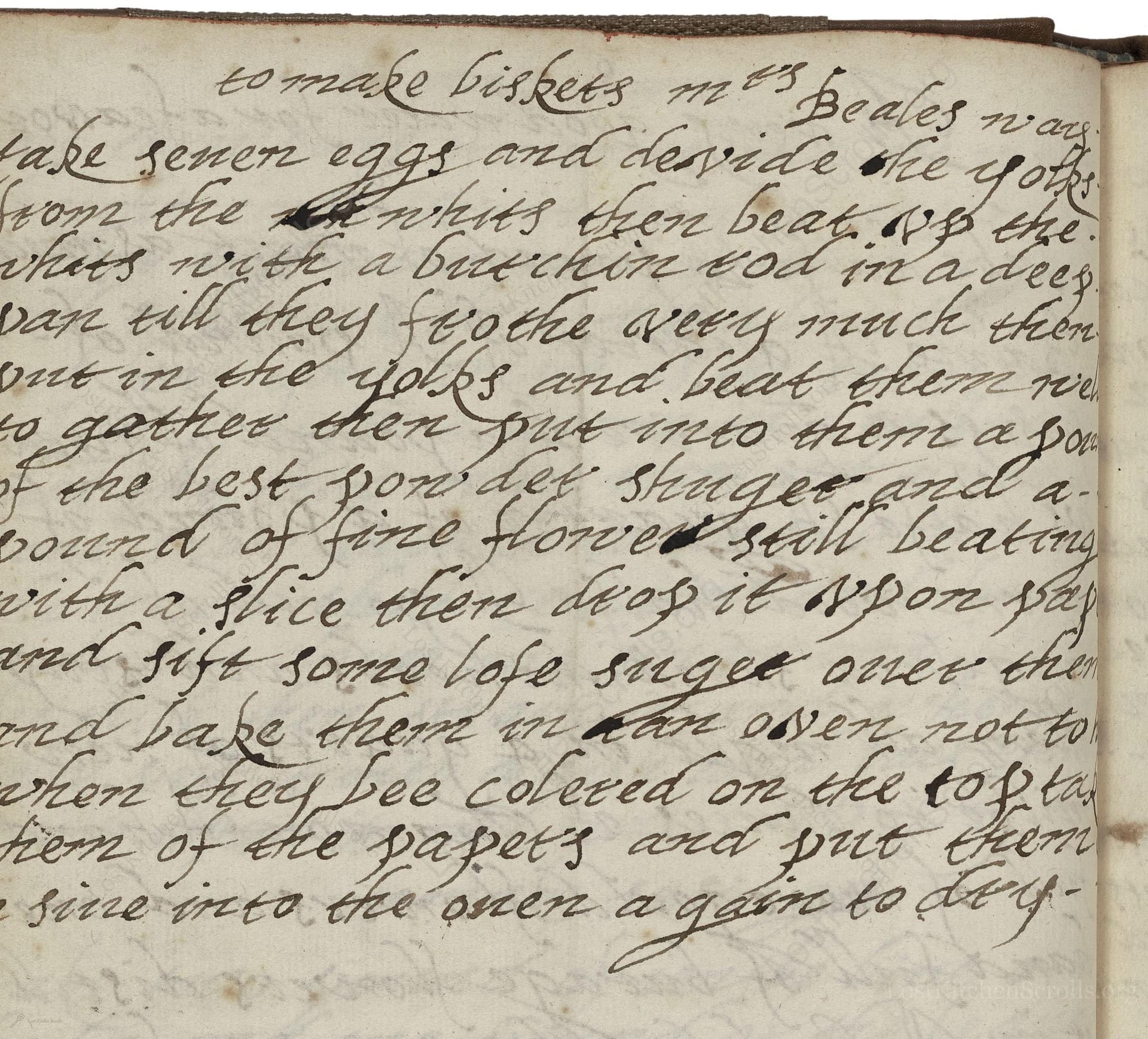To Make Biskets M^Rs Beales Way
From the treasured pages of Cookbook of Constance Hall
Written by Constance Hall

To Make Biskets M^Rs Beales Way
"take seven eggs and devide the yolks from the whites then beat up the whites with a busckin cod in a deep pan till they frothe very much then put in the yolks and beat them well to gather then put into them a pou=nd of the best pouder shuger and a pound of fine flouer still beating with a slice then drop it upon pap=er and sift some lose shuger over them and bake them in an oven not to be coleved on the tops take them of the papers and put them a sine into the oven again to dry."
Note on the Original Text
The recipe, written in the late seventeenth century, uses a conversational, almost oral style, assuming much prior knowledge and skipping over precise measurements and timings. Spelling is non-standard: 'biskets' for biscuits, 'shuger' for sugar, and 'pou=nd' with the equals sign used as a historical abbreviation. Instructions like 'not to be coleved on the tops' mean not to let the tops brown, reflecting delicate baking practices of the period. The recipe's brevity and lack of exact temperatures or written timings were common, given the variability of home ovens and the expectation that cooks possessed considerable practical experience.

Title
Cookbook of Constance Hall (1672)
You can also click the book image above to peruse the original tome
Writer
Constance Hall
Era
1672
Publisher
Unknown
Background
A spirited foray into 17th-century kitchens, this collection by Constance Hall brims with the flavors, secrets, and delicacies of Restoration-era England—perfect for cooks keen to revive a dash of history in their modern menus.
Kindly made available by
Folger Shakespeare Library
This biscuit recipe, attributed to Mrs. Beale and penned in 1672 by Constance Hall, comes from an English household manuscript—a survival from the 17th century, an age when sugar was precious and baking was still something of a luxurious art. These 'biskets' were likely enjoyed as a genteel treat, perhaps with tea or sack, and reveal how egg-based sponges began appearing in English kitchens as influences shifted away from heavier medieval sweets to lighter, airier bakes.

Traditionally, this recipe was executed with robust elbow grease and simple, sturdy tools. The egg whites would have been beaten in a deep earthenware or pewter bowl with a bundle of twigs or a birch whisk, sometimes called a 'buskin cod.' Mixing was done with a wooden slice or large spoon. The batter was dropped onto sheets of waxed writing-paper ('paper') or sometimes directly onto floured oven stones. Baking occurred in a wood-fired oven, carefully monitored to avoid 'colev[ing]'—browning—on top.
Prep Time
15 mins
Cook Time
15 mins
Servings
30
We've done our best to adapt this historical recipe for modern kitchens, but some details may still need refinement. We warmly welcome feedback from fellow cooks and culinary historians — your insights support the entire community!
Ingredients
- 7 large eggs
- 1 lb (about 3 3/4 cups) powdered (icing) sugar, plus extra for dusting
- 1 lb (about 3 1/3 cups) plain (all-purpose) flour
Instructions
- Begin by separating seven large eggs into yolks and whites.
- In a large, deep mixing bowl, whisk the egg whites energetically until very frothy, aiming for soft, billowy peaks—an electric mixer makes this much easier today.
- Beat in the egg yolks thoroughly, then fold in 1 pound (about 3 3/4 cups) of fine powdered sugar and 1 pound (about 3 1/3 cups) of plain flour, mixing gently until well combined but still light.
- Using a spoon, drop small mounds of the batter onto baking paper-lined trays.
- Sift a little more powdered sugar over the top.
- Bake in a preheated oven at 340°F (fan 300°F) for 10–15 minutes, or until the biscuits are just set and lightly golden, but not browned on top.
- Remove carefully from the trays and place back into the warm, turned-off oven to dry for a few minutes.
- Cool completely before serving.
Estimated Calories
90 per serving
Cooking Estimates
It takes about 15 minutes to prepare the dough and another 15 minutes to bake the biscuits. Each biscuit has about 90 calories, and this recipe makes around 30 biscuits.
As noted above, we have made our best effort to translate and adapt this historical recipe for modern kitchens, taking into account ingredients nowadays, cooking techniques, measurements, and so on. However, historical recipes often contain assumptions that require interpretation.
We'd love for anyone to help improve these adaptations. Community contributions are highly welcome. If you have suggestions, corrections, or cooking tips based on your experience with this recipe, please share them below.
Join the Discussion
Rate This Recipe
Dietary Preference
Occasions

Den Bockfisch In Einer Fleisch Suppen Zu Kochen
This recipe hails from a German manuscript cookbook compiled in 1696, a time whe...

Die Grieß Nudlen Zumachen
This recipe comes from a rather mysterious manuscript cookbook, penned anonymous...

Ein Boudain
This recipe comes from an anonymous German-language manuscript cookbook from 169...

Ein Gesaltzen Citroni
This recipe, dating from 1696, comes from an extensive anonymous German cookbook...
Browse our complete collection of time-honored recipes



